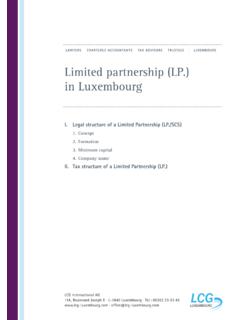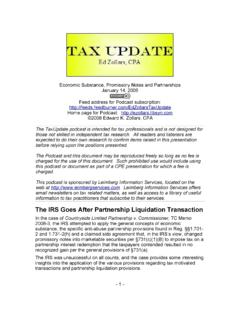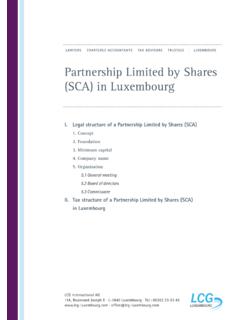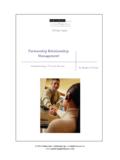Transcription of Buying and Selling a Partnership Interest: A …
1 1 Buying and Selling a Partnership interest : a checklist for the Tax Advisor1 Howard E. Abrams Warren Distinguished Professor, USD School of Law I. Tax Issues for the Selling Partner A. Computation of Gain or Loss Under section 741, a Selling partner computes her gain or loss from disposition of the Partnership interest by comparing the amount realized on the disposition with her adjusted basis in her Partnership interest (that is, with her outside basis ). In this context, amount realized includes the exiting partner s share of the Partnership s liabilities, where that share is determined under section 752. See 752(d) and Reg. (h), (a). Note that in determining the exiting partner s outside basis, distributive share for the year of sale must be taken into account. 706(d)(1); see Reg. (a) and the discussion below. These rules apply whether the interest is sold to one or more members of the Partnership or to one or more persons who are not currently members of the Partnership .
2 Reg. (b). However, a different set of rules applies if the interest is sold back to the Partnership ; that is, if the Partnership interest is redeemed in exchange for a liquidating distribution (or a series of distributions). If a Partnership interest is transferred in an exchange in which gain or loss is not recognized in whole or in part (such as a transfer to a controlled corporation as described in section 351 or to a Partnership under section 721), then the tax consequences of the transaction are determined under the applicable nonrecognition It may be the case that an exiting partner retains exposure on some of the partner s liabilities. Nevertheless, the partner s share of the liability is treated as being reduced to zero on the sale because, under section 752, a Partnership s liabilities must be allocated exclusively among its partners.
3 The definition of a Partnership liability is broad enough to encompass any liability that encumbers a Partnership s assets without regard to who else might bear the economic risk associated with nonpayment of the obligation. See 752(c). B. Character of Gain or Loss and Capital Gain Taxation 1. Character of Gain or Loss The gain or loss as determined under section 741 is the net gain or loss, but that net figure must be decomposed into its ordinary income and capital gain components. Under section 751(a), the 1 Copyright 2013-2015 by Howard E. Abrams. 2 Note that the transfer of a Partnership interest cannot qualify for nonrecognition under the like-kind exchange provisions in section 1031. 1031(a)(2)(D). 2 ordinary component from the disposition is determined by reference to the distributive share of ordinary income that would includible by the exiting partner if, immediately prior to the disposition, the Partnership sold each of its assets at fair market value in a fully taxable exchange.
4 Reg. (a)(2). Note that in determining the ordinary component of the transaction, all provisions that affect distributive share are taken into account including remedial and curative allocations under section 704(c)(1)(A) as well as curative and remedial allocations made under section 704(c) principles in connection with reverse section 704(c) adjustments. Ordinary income assets of the Partnership include unrealized receivables as well as inventory items (whether substantially appreciated or not), and the definition of inventory in this context is broad enough to capture any asset which, on sale or exchange by the Partnership , would be considered property other than property described in section 1231. 751(d)(2). The definition of unrealized receivables has been broadened to include almost every type of property that includes an ordinary income component (such as depreciable tangible property subject to ordinary income recapture under section 1245).
5 See 751(c) (final flush language). The capital gain component is then determined by subtracting the ordinary income component as determined under section 751(a) from the net income amount as determined under section 741. Note that the net income amount does not set a ceiling for the ordinary income or capital gain components. In particular, when the net amount of gain or loss is $0, the ordinary component can be positive and the capital component can be negative, or vice versa. 2. Capital Gain Component a. Rate To the extent that the Selling partner recognizes capital gain on the sale of a Partnership interest , the capital gain rate applicable to the gain is determined by reference to the assets of the Partnership . 1(h)(5)(B), 1(h)(9), 1(h)(10)(D); see also Reg. (h)-1(b)(3)(ii).
6 This look-thru rule applies only to collectibles and unrealized nonrecaptured section 1250 gain of the Partnership and not more broadly to such things as income described in section 1231. b. Holding Period Despite the number of distinct interests in a single Partnership that one partner may own, a partner has one capital account, Reg. (b)(2)(iv)(b), and the Service has long maintained that a partner also has a single, unified outside basis, Rev. Rul. 84-53, 1984-1 159. Nevertheless, a partner can multiple holdings periods with respect to the partner s unified interest in the Partnership . See generally Reg. A bifurcated holding period can arise either by contributing multiple properties to the Partnership at one time or by making multiple contributions to the Partnership over time. Reg.
7 (a). A partner having a bifurcated holding period can recognize both long- and short-term capital gain on the sale of her Partnership interest or from a distribution of cash (including marketable securities treated as cash under 731(c)) in excess of outside basis. See Reg. (c), -3(d)(2). Suppose that X is a member of the P Partnership , and assume that X has a holding period in its Partnership interest in excess of one year. If the fair market value of X s interest equals $500 and X 3 contributes additional cash of $250 to the Partnership (increasing the value of X s interest to $750), then X will be treated as having a short-term holding period in one-third of the Partnership interest because of the cash contribution. So, for example, if X sells her Partnership interest six months later, one-third of any gain or loss will be short-term.
8 Note that this is true even though all of the appreciation in X s Partnership interest may have accrued many years earlier. Note also that this result would not change if X had contributed property rather than cash unless the property had been a capital asset in X s hands immediately prior to the contribution and X had had a holding period in the contributed property in excess of six months. See 1223(1) (tacking for substitute basis capital assets). As a general rule, distributions from a Partnership do not affect the distributee partner s holding period in the Partnership interest . Reg. (d)(1). However, distributions of cash can reduce the shirt-term portion of a bifurcated holding period because only the net cash contributions made during any 12-month period create a bifurcated holding period for an otherwise long-term Partnership interest .
9 Reg. (b)(2). For this purpose, deemed distributions arising from a decrease in a partner s share of Partnership liabilities are ignored. Reg. (b)(3). Deemed contributions arising from an increase in liability share equally are ignored. Id. 3. Installment Sales A Partnership interest can be sold with one or more payments received in the year after the year of sale. In such circumstances, the sale will be taxed to the Selling partner under the installment method unless the Selling partner makes an election to the contrary. See 453(a). In computing gain under the installment method, the Selling partner s share of the Partnership s indebtedness is not treated as a payment received in the year of sale, at least if the debt share does not exceed the Selling partner s outside basis. Rev. Rul. 76-483, 1976-2 131.
10 And while sections 453(b) and 453(i) deny installment sale treatment for sales of inventory and depreciation recapture, these provisions do not include an express look-through rule applicable to sales of Partnership interests. Nevertheless, the Service has ruled that installment sale treatment is inapplicable to the gain recognized on the sale of a Partnership interest to the extent attributable to Partnership inventory and depreciation recapture. Rev. Rul. 89-108, 1989-2 100. Note that because the reach of section 751(b) is broader than that of sections 453(b) and 453(i), it is unclear if the Service will deny installment sale treatment to the sale of a Partnership interest to the extent of the Selling partner s share of all ordinary income items. In Mingo v. Commissioner, Memo 2013-149, 773 629 (5th Cir.)







